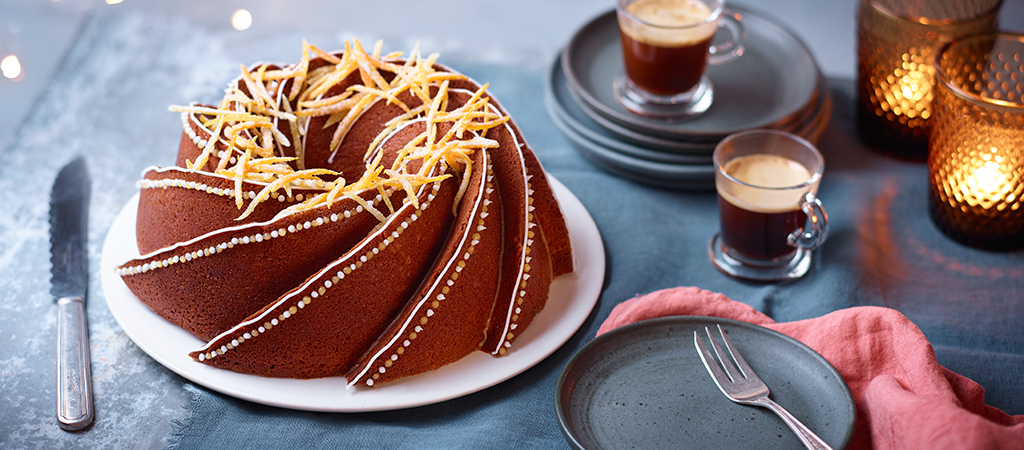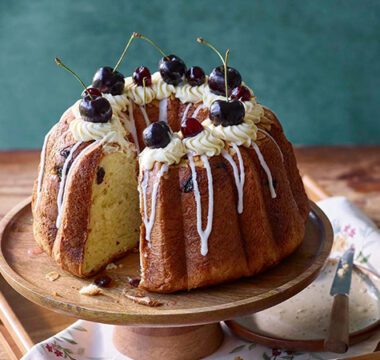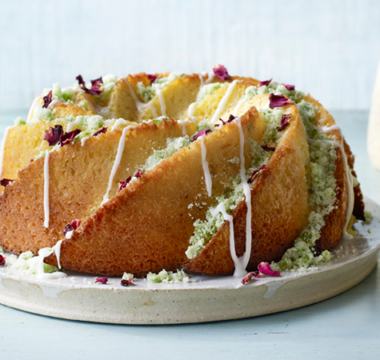Based on the Greek New Year’s Cake, vasilopita, this citrus bundt is flavoured with Greek spices mahleb and mastic. The sweetness in the sponge symbolises the hope that the New Year will be filled with the sweetness of life, liberty, health and happiness.


Paul Hollywood
Christmas & New Year Specials
- Ingredients
- Method
Method
Step 1
Heat the oven to 180°C/160°C fan/350°F/Gas 4.
Step 2
Make the sponge. Beat the butter and sugar together in a stand mixer fitted with the beater attachment for 3–5 minutes on medium speed, until light and fluffy, scraping down the sides of the bowl from time to time.
Step 3
One at a time, add the eggs, beating well between each addition – add a spoonful of flour if the mixture begins to, curdle and beat again.
Step 4
Sift the flour, mahlab and mastic over the mixture and beat on a medium–low speed until combined. Add the yoghurt and lemon zest and mix to a thick dropping consistency.
Step 5
Spoon the sponge mixture into the greased bundt tin and, using a spatula, push the batter up the sides of the tin – this helps the sponge to rise evenly. Bang the tin on the work surface three times, to release as many air bubbles as possible.
Step 6
Bake the sponge for 40–45 minutes, until a skewer inserted into the centre comes out clean, then remove the sponge from the oven and leave it to cool in the tin for 10 minutes. Then, turn out the sponge onto a wire rack and leave it to cool completely.
Step 7
While the sponge is baking, make the curd. Put the lemon juice, sugar and butter into a heatproof bowl. Sit the bowl over a saucepan of gently simmering water, making sure the water is not touching the base of the bowl. Stir the mixture every now and again until all the butter has melted.
Step 8
Meanwhile, lightly whisk together the egg and egg yolk in a small bowl. Once the butter has melted, stir the egg into mixture in the bowl and whisk until everything is well combined. Leave to cook over the simmering water, stirring from time to time, for 8–10 minutes, until the mixture is creamy and it is thick enough to coat the back of a spoon.
Step 9
Remove the bowl of lemon curd from the heat, and spread the curd out over a plate to cool. Once cool, transfer it to the fridge and chill it until it’s set (about 1 hour). Spoon the set curd into one of the piping bags fitted with a No.2 writing nozzle.
Step 10
Towards the end of the sponge baking time, make the crystallised orange and lemon. Using a potato peeler, peel the lemon and orange in strips from top to bottom. Cut the orange and lemon peel into fine matchsticks, then tip the matchsticks into a small saucepan.
Step 11
Add the sugar and 100ml of water to the pan, place the pan over a medium heat and bring the liquid to the boil. Reduce the heat and simmer for 15 minutes, until the peel matchsticks are translucent and soft.
Step 12
Strain the matchsticks through a sieve, then spread them out onto the unlined baking sheet and sprinkle them with sugar. Toss to coat each piece, then transfer them to the lined baking sheet, arranging them in a single layer. Once you have removed the baked sponge from the oven and turned the oven off, place the peel matchsticks in the oven and leave them in the residual heat for 30 minutes to dry and crystallise.
Step 13
To decorate the bundt, sift the icing sugar into a bowl, add the lemon juice and mix to a stiff, but pourable icing. Spoon the icing into the second piping bag fitted with a No. 2 writing nozzle.
Step 14
Pipe a line along the top of each ridge of the bundt cake and then pipe a line of lemon curd along each valley. Pipe small dots alternating between icing and lemon curd underneath the piped line of icing.
Step 15
To serve, swirl the remaining lemon curd through the crème fraîche and spoon this into a serving bowl.
Step 16
Place the decorated bundt onto a cake stand or cake plate and sprinkle the crystallised lemon and orange pieces on top. Serve with the lemony crème fraîche alongside.












